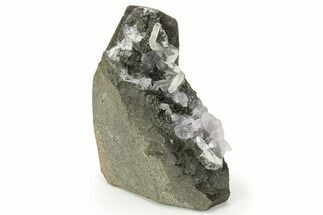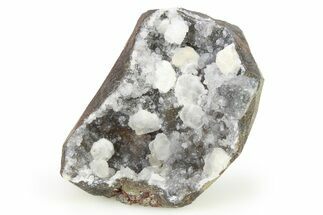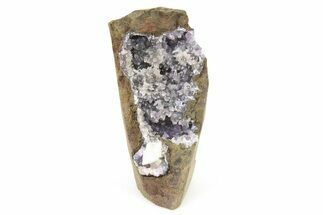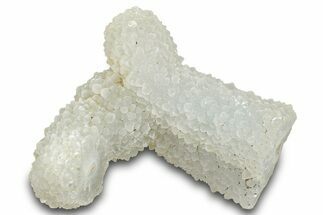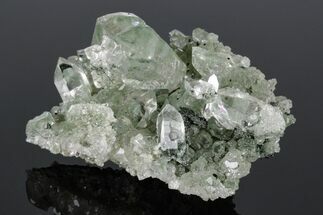This Specimen has been sold.
1.4" Chalcedony Encrusted Quartz and Chabazite Crystals - India
This is a beautiful, 1.4" wide specimen that features an association of quartz crystals and chabazite crystals that are encrusted in chalcedony, collected from Madhya Pradesh, India. This formation occurred within a cavity/vug in the basalt host rock. Apophyllite, barite, and julgoldite crystals have also been reported as being present within some of these vugs.
About Chabazite
Chabazite is an eye-catching mineral from the zeolite group, admired for its beautifully symmetrical crystal structure and pastel colors. Typically forming in rhombohedral or cubic-like crystals, chabazite often appears in hues of white, pink, orange, or light yellow. This mineral is primarily composed of hydrated calcium aluminum silicate, giving it a lightweight, porous structure that enables it to act as a natural ion-exchanger—a property commonly seen in zeolites.
Chabazite crystals have a vitreous to pearly luster, and their transparent to translucent appearance gives them an almost delicate, ethereal quality. With a hardness of about 4.5 to 5 on the Mohs scale, chabazite is moderately soft, making it suitable for display rather than wear. It typically forms in cavities within volcanic rocks like basalt and andesite, where it grows alongside other zeolite minerals such as heulandite, stilbite, and analcime. Some of the finest chabazite specimens come from Iceland, Italy, and India, renowned for their vivid color and well-formed crystals.
Chabazite is an eye-catching mineral from the zeolite group, admired for its beautifully symmetrical crystal structure and pastel colors. Typically forming in rhombohedral or cubic-like crystals, chabazite often appears in hues of white, pink, orange, or light yellow. This mineral is primarily composed of hydrated calcium aluminum silicate, giving it a lightweight, porous structure that enables it to act as a natural ion-exchanger—a property commonly seen in zeolites.
Chabazite crystals have a vitreous to pearly luster, and their transparent to translucent appearance gives them an almost delicate, ethereal quality. With a hardness of about 4.5 to 5 on the Mohs scale, chabazite is moderately soft, making it suitable for display rather than wear. It typically forms in cavities within volcanic rocks like basalt and andesite, where it grows alongside other zeolite minerals such as heulandite, stilbite, and analcime. Some of the finest chabazite specimens come from Iceland, Italy, and India, renowned for their vivid color and well-formed crystals.
SPECIES
Quartz var. Chalcedony, Quartz & Chabazite
LOCATION
Khadakwani, Madhya Pradesh, India
SIZE
1.4 x .95"
CATEGORY
ITEM
#220084
 Reviews
Reviews
